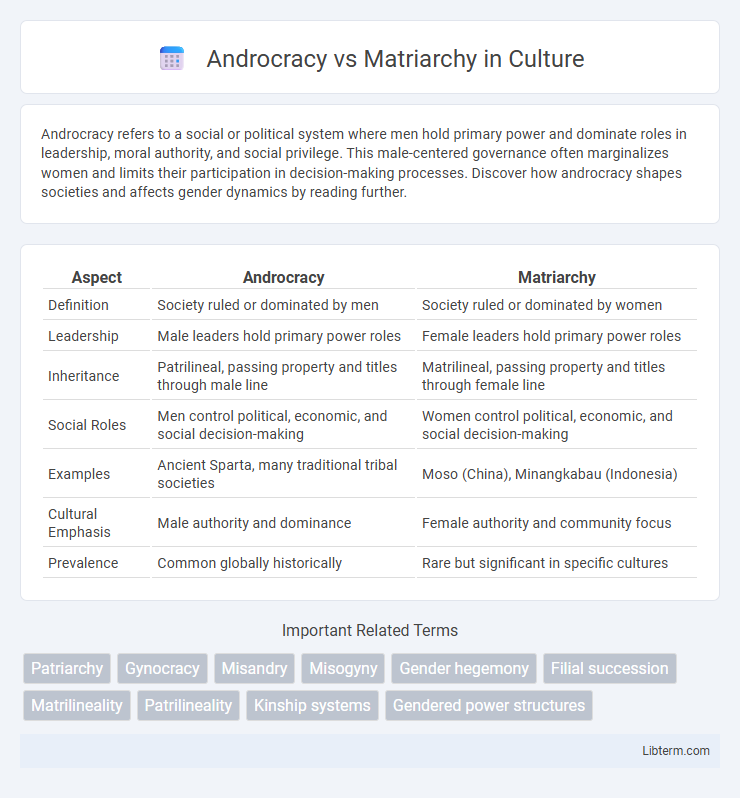Androcracy refers to a social or political system where men hold primary power and dominate roles in leadership, moral authority, and social privilege. This male-centered governance often marginalizes women and limits their participation in decision-making processes. Discover how androcracy shapes societies and affects gender dynamics by reading further.
Table of Comparison
| Aspect | Androcracy | Matriarchy |
|---|---|---|
| Definition | Society ruled or dominated by men | Society ruled or dominated by women |
| Leadership | Male leaders hold primary power roles | Female leaders hold primary power roles |
| Inheritance | Patrilineal, passing property and titles through male line | Matrilineal, passing property and titles through female line |
| Social Roles | Men control political, economic, and social decision-making | Women control political, economic, and social decision-making |
| Examples | Ancient Sparta, many traditional tribal societies | Moso (China), Minangkabau (Indonesia) |
| Cultural Emphasis | Male authority and dominance | Female authority and community focus |
| Prevalence | Common globally historically | Rare but significant in specific cultures |
Understanding Androcracy and Matriarchy
Androcracy refers to a social system where men hold primary power and dominate roles in political leadership, moral authority, social privilege, and control of property. Matriarchy is a societal structure where women, especially mothers, have central roles in leadership, moral authority, and control of lineage or property. Both systems influence gender dynamics, power distribution, and cultural norms, shaping societal hierarchies and governance.
Historical Roots of Androcratic Societies
Androcratic societies, characterized by male dominance in political and social institutions, trace their historical roots to ancient civilizations such as Mesopotamia, Greece, and Rome, where patriarchal structures centralized authority among men. The inheritance systems and legal codes like Hammurabi's Code reinforced male control over property and family lineage, solidifying androcratic governance. These foundational norms influenced subsequent state formations, perpetuating male-dominated power hierarchies across diverse cultures and epochs.
Origins and Examples of Matriarchal Systems
Matriarchal systems originate from early human societies where women held primary authority in social, political, and familial structures, emphasizing kinship through the maternal line. Examples include the Mosuo people of China, known for their matrilineal descent and household management by women, and the Minangkabau of Indonesia, where property and clan identity pass through the female line. These societies demonstrate how matriarchal organization influences community roles, inheritance, and cultural practices distinct from androcracy, which centers male dominance in power and governance.
Power Structures: Contrasts and Comparisons
Androcracy establishes power predominantly in the hands of men, often prioritizing patriarchal norms and male authority in governance and societal roles. Matriarchy, by contrast, centers authority around women, emphasizing maternal lineage and female leadership in social, political, and economic systems. These contrasting power structures reveal divergent approaches to leadership, inheritance, and cultural values, impacting gender dynamics and societal organization fundamentally.
Gender Roles in Androcracy vs Matriarchy
In androcracy, gender roles are primarily centered around male dominance, with men holding the majority of political power, social authority, and economic control while women often occupy subordinate or domestic roles. Matriarchy, in contrast, emphasizes female leadership and social influence, often granting women pivotal roles in decision-making, lineage, and resource distribution. These distinct frameworks shape societal expectations, responsibilities, and power dynamics based on gender in fundamentally opposite ways.
Societal Impact of Androcratic Governance
Androcratic governance, characterized by male-dominated leadership, often leads to societal structures that prioritize patriarchal values, influencing laws, economic opportunities, and social norms to favor men. This governance model tends to reinforce gender inequalities, limiting women's access to political power and decision-making roles, thereby affecting social mobility and resource distribution. The societal impact includes entrenched gender roles, reduced diversity in leadership perspectives, and potential hindrance to inclusive economic and social development.
Cultural Outcomes of Matriarchal Leadership
Matriarchal leadership often fosters inclusive decision-making processes that emphasize communal well-being and cooperation, resulting in societies with lower levels of conflict and stronger social cohesion. These cultures tend to prioritize nurturing roles, environmental stewardship, and equitable resource distribution, which enhances social harmony and sustainable living practices. Research indicates that communities under matriarchal influence frequently exhibit egalitarian gender relations and increased support networks that contribute to overall cultural resilience.
Evolution of Gendered Authority Over Time
Androcracy, characterized by male-dominated authority, historically emerged alongside patriarchal kinship systems and agricultural societies, reinforcing male control over resources and decision-making. In contrast, matriarchy, while less prevalent, exemplifies social structures where women hold power, often associated with matrilineal descent and communal resource management. Over time, shifts in economic, social, and environmental factors have influenced the balance of gendered authority, leading to complex hybrid governance models rather than absolute androcratic or matriarchal dominance.
Contemporary Relevance of Androcracy and Matriarchy
Androcracy, a system dominated by male authority, remains prevalent in contemporary politics, business, and cultural institutions, often influencing gender roles and power dynamics worldwide. Matriarchy, though less common as a formal governance structure, is increasingly studied for its emphasis on egalitarian values and social cohesion, offering alternative models for addressing gender inequality today. Both systems illuminate ongoing debates about gendered leadership and inform policies aiming to balance representation and inclusivity in modern societies.
Future Perspectives: Balancing Power and Gender
Emerging research in gender studies emphasizes the necessity of harmonizing androcracy and matriarchy by promoting inclusive governance models that integrate masculine and feminine leadership traits. Future perspectives advocate for equitable power distribution through policies fostering gender diversity, which can enhance decision-making efficacy and social cohesion. Technological advancements and shifting cultural norms further support the potential transition toward balanced gender representation in political and organizational hierarchies.
Androcracy Infographic

 libterm.com
libterm.com